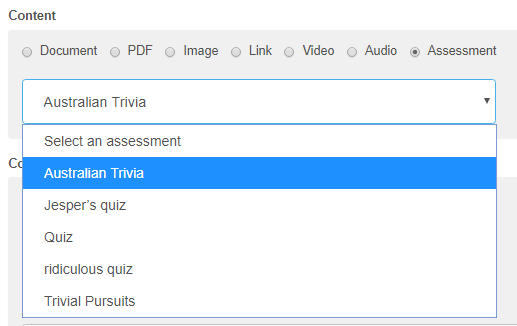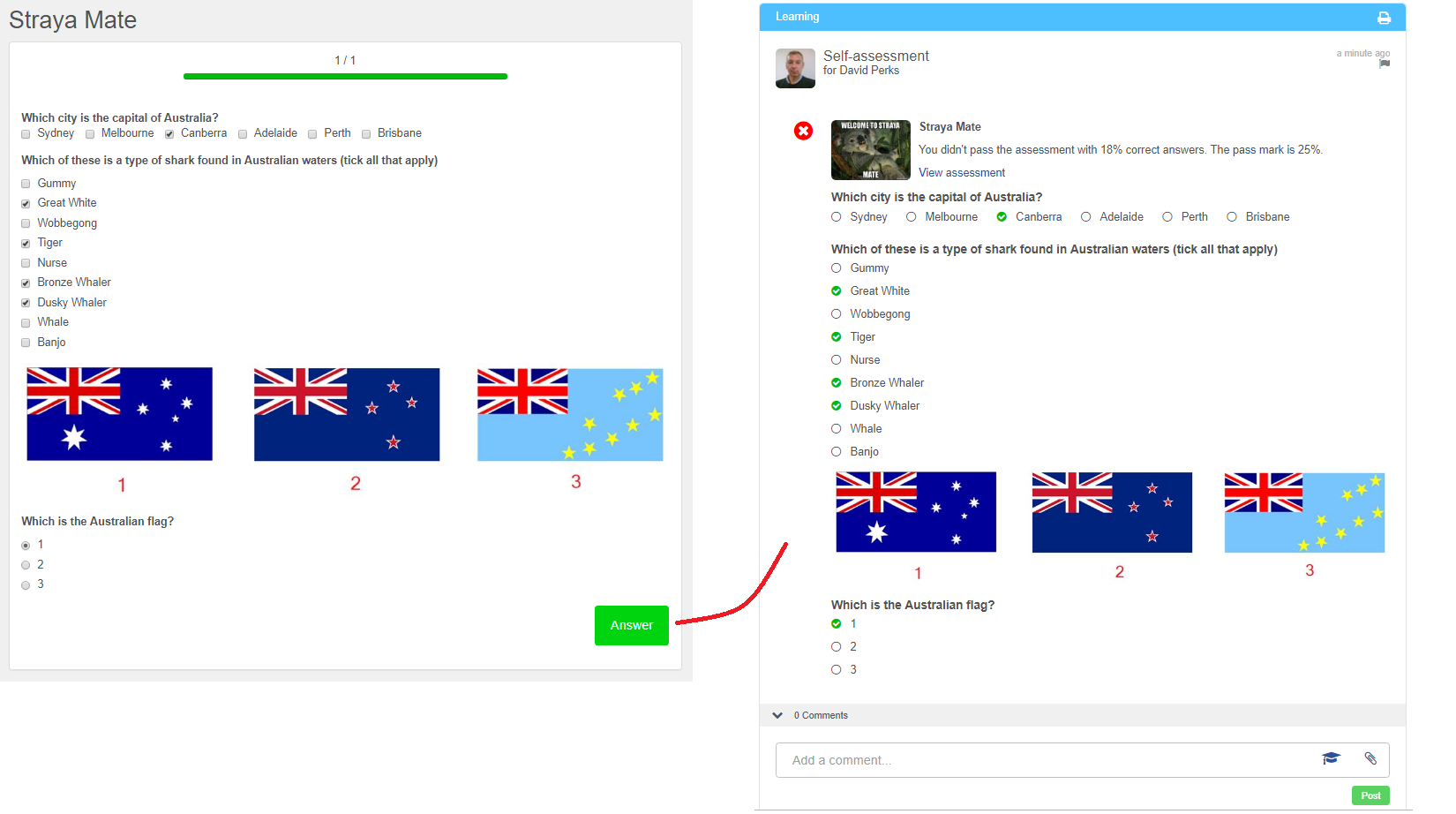
Learning in the moment
Readers of this blog will know that we are strong advocates of micro-learning. You'll also know that we are fanatical about impact, measurement and metrics.
This post is about measuring the impact of micro-learning through our latest feature of knowledge tests and assessments which we've added to the micro-learning experience.
But first, let's recap the memorability and measurability tools we already had ....
Reflections
When we introduced micro-learning we made provision for reflections.
Reflections are free format notes. A record of the learners' insights gained. They are designed to cement the takeaways from the learning content for the learner in the moment and to be available later to look back on to remind or to prompt reappraisal.
Within our learning experience, we've made it impossible to add an entry to your learning record store without first reflecting on what you took from the material, good or bad.
In our dashboards, we mine the learning reflections to find patterns of needs, questions and insights that workers are experiencing.
Reflections are powerful but they still leave a question mark over the stickiness of micro-learning.
Is micro-learning absorbed and disposed of in the moment, never really making it to long term memory, or is it so attuned to time of need and relevancy that it cuts through far better than conventional classes and courses?
We don't think that the answer is as clear cut as organisations would like it to be. Learning and Development professionals seem divided in their views.
It's an important question particularly when it comes to regulation and compliance. Certainty of participation falls short of certainty of impact and that might carry high risk.
To get to the bottom of this we've added assessments to the learning platform, to help organisations and leaders to measure the impact of learning as it happens, and any time after so that acquired knowledge and skill can be tested for.
Assessments
Assessments are intended to be quick question and answer tests of knowledge or skill. We see them being created around topics of high importance for the organisation, yet agile as such topics emerge. We expect them to be quite dynamic in the way they are launched and withdrawn or updated.
We've added assessments as a new type of form within the Pay Compliment form builder, giving loads of flexibility in how they are designed.
They contain a new set of field types that control the behaviour of the assessment with options to
1. Set a pass mark
2. Stop the assessment on an incorrect answer
3. Provide reinforcing information for correct and incorrect answers, and
4. Differentiate between responses with weighted answers
Learners complete assessments either as pre-learning, mid-learning or post-learning knowledge tests that can be repeated as necessary to confirm learning objectives, compliance needs, acquired knowledge or competency.
Dashboards show pass/fail and well as the distribution of answers, trending over time, and drill down from organisation to business unit, team and individual as you'd expect.
Spaced learning and rediscovery
Assessments can do more than measure competency.
When used with our campaign functionality assessments can be an effective way to build competency
Sending follow up's to learning in a spaced learning approach is proven to improve learning retention and assessments/quizzes/tests make for the perfect follow up technique.

Beyond directly spacing learning, the course or resource including results of assessments are visible in the learners' chronology of performance. Similar to a social media timeline, they are there to be re-seen the next time the learner scrolls through recent events, and to be rediscovered any time the learner is recapping their record of progress, for example in preparation for a check-in or periodic review.
Overall learning is much more visible to the learner by being added to their learning record store, than visibility in a traditional LMS.
Insights
The types of insights gleaned from assessments are potentially quite different than those we learn from reflections.
Reflections are unstructured and lead to qualitative insights around learner sentiment, unresolved questions and ponderings.
Assessments are structured and they open up opportunities for quantitative.analysis.
For example, repeating the same assessment at longer intervals might indicate how far refresher training can be stretched without increasing compliance risk.
Pre-assessments might be used just before learning content is created to produce or tailor content that's the best fit for the needs of this cohort, not the last group through.
With assessments and micro-learning being so rapid to deploy, they create an ability for L&D to be far more agile.
We see this opening up potential to test and adapt learning programs during design but also whilst they are in flight As learning takes more cue's from marketing, we can envisage 'split testing' of learning and assessment to optimise approaches for audiences by working with sample groups and knowing their reactions better.
We believe assessments and analytics are an essential yet missing element in the movement to micro-learning. Their purpose is not to answer the question "Does micro-learning stick?" but to find the answers to the question of "What makes this micro-learning stick for this audience?"
We've done (some of) the hard work for you
Assessments are integrated into the feedback and learning experience so that you don't need to worry about how to build them, deliver them, chase them up or analyse them.
That's all available within our standard learning feature set.
Where your hard work begins is in designing assessments and using insights to prove the impact of learning in your organisation. This is a goal in which we are more than happy to assist.
Please contact us to find out more about assessments, spaced learning and learning record stores, or read on to see how straightforward they are to create.
The mechanics
As always we've tried to keep the development of assessments as simple as possible. There's a new type of form in the form builder that provides extra assessment field types.

The new field types are all prefixed and identifiable as assessment fields so it's easy to know where questions and answers are supported.

For now, assessments are based on multiple choice responses. These can be presented as check box lists, dropdowns and radio button lists.
Answers can be 'marked' on a question by question basis, or as groups of questions. Simply drop in an answer page as a divider where you want the assessment responses to be shown.
Set up is very straightforward, simply define the question and choices of answers, then specify what should happen for correct and incorrect responses.

Repeat this process to design the entire assessment adding pictures, video and other media to make the assessment engaging and fun!
Once your assessment is complete and tested in the form builder, publish the form so that it's available to add into micro-learning resources.
Go to the learning library and insert the assessment into the appropriate course or resource.
There's a new content type (of assessment) that lists the published assessments to choose from

Once you've embedded your assessment into a resource and made that live, it will show up in the learning library for self-directed learners, and become available to use in learning campaigns for non-discretionary learning.

The learner can start and return to the assessment as time permits. We want this to conform to micro-learning principles after all.
They will see their results as they progress through the questions, or at the very end, depending on how questions have been grouped in the design.
When the entire assessment is completed, the learner will receive a final score, and a record of their results will be added to their learning record as below.

We believe this is a strong method of reinforcement for learning that is generally missing in micro-learning platforms.
Micro-learning is still fairly new, and to-date the emphasis has been on easy access and fast consumption, not necessarily on mindful longlasting personal development.
We look forward to seeing what our customers create with this feature, and what measures of effectiveness we see on the way.
Let us know your thoughts in the comments.